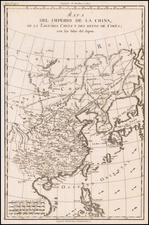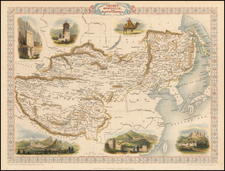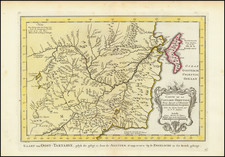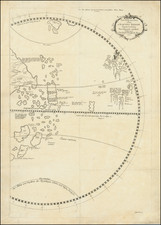A highly decorative and important 17th Century map of the area now covering China's Jiangsu Province and Shanghai Municipality, by Joan Blaeu, based on the landmark surveys of the Jesuit Missionary Martino Martini.
This beautiful map focuses on the lower Yangtze River and includes what was then Nanjing Province (here called 'Kiangnan'), which includes modern Jiangsu Province and the Shanghai Municipality. Mountains, rivers, lakes and salt marshes are finely engraved, while cities and towns are conveyed by their hierarchy. An elegant title cartouche, framed by rightly dressed Mandarins, graces the lower left corner.
Nanjing, which means "Southern Capital" was one of the Four Ancient Captials of China, having first served as the captial of the Wu Kingdom during the Three Kingdoms Period in 229 AD. During the Ming Dynasty (1368-1644), Nanjing was one of the Chinese Empire's two capitals (along with Beijing) and was one of the most populous cities in the world. During the twillight of the Ming Dynasty, following the fall of Beijing to the Qing Emperor Li Zicheng, in June 1644, the Ming Prince Zhu Yousong was enthroned in Nanjing as the Hongguang Emperor. His brief reign was described by later historians as the first reign of the so-called Southern Ming Dynasty, which survived with decreasingly smaller territory until it was extinguished by the Manchus in the 1660s. During the period that this map was made, the early years of the Qing Dynasty (1644-1911), the Nanjing area was known as Jiangning and served as the seat of government for the Liangjiang Viceroy.
Shanghai was located near where "Changno" is labelled on the map. Shanghai was then a small county town and its rise to become a great port would not occur until the Qing rulers elminated the late Ming's prohibition on offshore sea travel in 1684.
Other notable cities include "Suchou" (Suzhou), then a major city beside Taihu Lake and "Hangchou" (Hangzhou, Zhejiang), which was one of the China's Four Ancient Capitals.
The Atlas appeared both as a separate publication and as a part of Blaeu's Novus Atlas and later his Atlas Maior and is based on the surveying and compiling work of Father Martinus Martini, the Jesuit Superior of Hangzhou.
The seventeen maps are noteworthy not only for their accuracy, remarkable for the time, but also for their highly decorative cartouches featuring vignettes depicting regional Chinese dress, activities, and animals. In addition, it is one of the first true Sino-European publications, based on Chinese land surveys but presenting geographic data in a highly visual European cartographic format. - Reed & Demattè
Jesuit China Missions
The Jesuit missions in China represented perhaps the most important conduit between West and East during the late Renaissance and early Age of Enlightenment. The Jesuits first attempted to reach China in 1552, when St. Francis Xavier reached the mainland. He died after only one year in Shangchuan. From that point until 1800, a total of 920 Jesuits participated in the China mission. 314 of the missionaries were Portuguese.
The Jesuit missionaries were particularly important in disseminating European cartographic information in China -- such as with Matteo Ricci's famed Wanguo Quantu 萬國全圖, a large woodblock world map with Chinese characters -- a role which had long- and wide-reaching impact into the 19th century. The relay of information worked the other way too, probably most importantly with the efforts of Father Martini.
Martino Martini
Martino Martini (卫匡国) (1614-1661), was born in Trento, in the Bishopric of Trent. He entered the Society of Jesus in 1631, after finishing his schooling. He had a strong interest in astronomy and math, and he was able to study under Athanasius Kircher. Martini continued his theological studies in Portugal, on his way to Rome, and was ordained in 1639.
He left Portugal for China in 1640, and arrived in Macau in 1642. He settled on the mainland in Hangzhou, Zhejiang Province, which he used as a base in his traveling around the country.
Martini had arrived in China at the very end of the Ming dynasty; in 1644, the last legitimate Ming Emperor, the Chongzhen Emperor, hanged himself. The Qing Dynasty then rose, and when Manchu forces came to the town where Martini was staying, he was asked to pledge his loyalty to the new dynasty. He agreed, and his head was shaved in the Manchu manner, and he adopted Manchu-style Chinese dress.
In 1651, Martini left China, taking an adventurous peregrination to Amsterdam by way of the Philippines and Bergen, Norway. He arrived in Amsterdam in 1653 and took his collection of manuscript surveys to Johannes Blaeu for publication.
The collection of maps that Martini imparted to Bleau is worthy of close examination. He carried with him a copy of the Ming dynasty manuscript atlas by Zhu Siben (compiled 1311/12), with revisions from the printed atlas by Luo Hongxian -- his "Guangyu tu" (enlarged terrestrial atlas, 1579). Martini was a capable cartographer and compiled the maps himself. In fact, he convinced Bleau to postpone the publication of other volumes in the Atlas Maior to work on the Chinese atlas.
Martini's goal was to return to Rome, and he took his time to make many stops along the way. He visited printers in Antwerp, Vienna, and Munich, relaying his discoveries about China, which were in turn published in books that made him famous. On this trip, he also met his 10-year old cousin, Eusebio Kino, who would go on to conclusively prove the falsity of the California as an Island myth.
Martini reached Rome in 1655 and left for China again in 1657. He died in Hangzhou in 1661.
Reference
Joan, or Johannes, Blaeu (1596-1673) was the son of Willem Janszoon Blaeu. He inherited his father’s meticulous and striking mapmaking style and continued the Blaeu workshop until it burned in 1672. Initially, Joan trained as a lawyer, but he decided to join his father’s business rather than practice.
After his father’s death in 1638, Joan and his brother, Cornelis, took over their father’s shop and Joan took on his work as hydrographer to the Dutch East India Company. Joan brought out many important works, including Nova et Accuratissima Terrarum Orbis Tabula, a world map to commemorate the Peace of Westphalia which brought news of Abel Tasman’s voyages in the Pacific to the attention of Europe. This map was used as a template for the world map set in the floor of the Amsterdam Town Hall, the Groote Burger-Zaal, in 1655.
Joan also modified and greatly expanded his father’s Atlas novus, first published in 1635. All the while, Joan was honing his own atlas. He published the Atlas maior between 1662 and 1672. It is one of the most sought-after atlases by collectors and institutions today due to the attention to the detail, quality, and beauty of the maps. He is also known for his town plans and wall maps of the continents. Joan’s productivity slammed to a halt in 1672, when a fire completely destroyed his workshop and stock. Joan died a year later and is buried in the Westerkerk in Amsterdam.









![[Shannxi Province] Xensi, Imperii Sinarum Provincia Tertia](https://storage.googleapis.com/raremaps/img/small/99964.jpg)
![[Summer Palace] The Map of Yu Ho Yuan Won Shou Shan Including Kuen Ming Hou Near of Peking](https://storage.googleapis.com/raremaps/img/small/60906.jpg)



